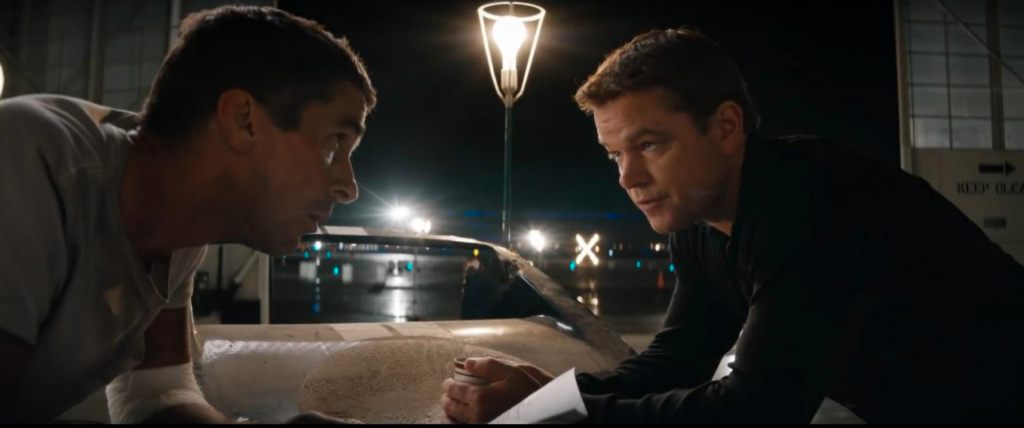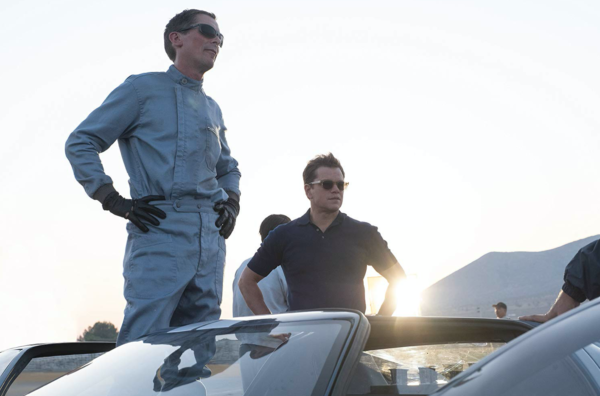A failed merger between two of the best known automotive brands in the world devolved into a grudge match, culminating in a 24-hour race in Le Mans, France. The real-life story behind Ford v Ferrari is filled with corporate intrigue, ego-driven personalities, and high (speed) stakes—an irresistibly high-octane package for any Hollywood studio. Yet despite the high-profile stars and directors attached to the project over many years, the film seemed destined to remain stalled until James Mangold, hot off the success of Fox’s R-rated Logan, came to the helm.
Mangold’s Ford v Ferrari focuses on car designer Carroll Shelby (Matt Damon) and race car driver Ken Miles (Christian Bale) and their mission to build a sports car for Ford that could beat incumbent champion Ferrari at the 24 Hours of Le Mans—an iconic race that pits the world’s leading car manufacturers against each other. Based on the real events surrounding the 1966 edition of the race, Ford v Ferrari stands out in today’s super-hero-dominated release calendar as an adult-skewing spectacle arriving at theaters just ahead of Thanksgiving.
Boxoffice Pro spoke to director James Mangold ahead of the film’s release to understand what drove him to the project, his approach to the movie’s unique visual style, and the role these types of films play in today’s film industry.
This project had been bouncing around Hollywood for years but always stalled when it came to getting it made. What attracted you to this film, and what finally made the difference in moving it forward at 20th Century Fox?
It had a bumpy road getting—or not getting—made for a decade. I had been keeping track of the movie since about 2011. I read some existing scripts and felt like I had my own idea about what I could do to make it affordable. One of the problems with the movie was that there were so many wonderful stories to tell that no one had figured out how to get it to a level that would convince a studio to pay to make it. After Logan, I asked about it again at Fox and they sent the script over to me. I jumped in with [screenwriters] the Butterworth brothers and, went about trying to make the movie into something we could do for well under a hundred [million] and that leaned even more into the two central characters, focusing even more on their friendship.
What were the structural changes you and the screenwriters introduced to keep that budget under control?
When I came on, my desire was to streamline the story and focus it on the two [lead] characters. In previous versions, the film was following all the characters. … I couldn’t see how to make that movie less than four hours long. … I felt there was a way to telescope it down and focus it [on the two leads]. It was a way to invest more of our money and our time on a smaller group of characters instead of trying to be quite so epic about it.
The core of the movie focuses on the challenge of building a Ford sports car that can beat a Ferrari, saving the big set piece at Le Mans until the final act.
I kept telling my crew that we were making Saving Private Ryan in reverse. [That movie opens with a big action sequence] and then becomes more of a drama and character piece through to the end of the picture. That allowed us to dedicate the last hour of the movie completely immersed in Le Mans. I didn’t want the race to be this montage sequence where we keep cutting to the scoreboard; you can really feel like you’re living in the race—you’re in the trenches and behind the wheel and get to experience what it feels like to live through a 24-hour race.
You mentioned you kept a close eye on the production in order to keep the budget under control. How did that impact your choice of locations?
We built the grandstand from Le Mans in Agua Dulce, California. The rest of the track was a varied set of locations in Georgia; every time you see a car do one full rotation around the track, it’s passing through about five disparate locations in Georgia. You could only imagine the amount of effort that was required with light direction, rain, no rain, dirt level on cars, car positions in relation to each other, speed consistency between the shots—you’re shooting all these pieces separately on different days at different locations where they have to convey a single, nonexistent loop.

On a technical level, your use of sound throughout the film really stands out. I saw the film at the DGA New York Theater, which has a great Dolby sound system, and it struck me as one of the only films in recent years where the sound mix plays a crucial role.
A lot of great sound people, including the ones I’ve worked with, will tell you that nine-tenths of great sound in a movie is not just what you do, but what you don’t do. When you use and don’t use ambient sound and [extra-diegetic] music. In this movie, when you hear a Ferrari, it’s a Ferrari; when you hear a GT 40, it’s a GT 40; when you hear an Aston Martin, it’s an Aston Martin. All these cars have their own distinctive sounds and each has its own character. We really leaned into that and tried to share that with the audience.
How familiar were you with motor sports when you started work on this movie?
I didn’t know anything about motor sports. I just loved the characters. What might have gotten in the way of the movie happening for other filmmakers and their teams was that they were so into cars that they couldn’t cut anything. For me, if someone said, “We have to see this scene because it’s the where the GT 40 develops its spoiler,” I’d be like, “Who gives a shit?” The audience doesn’t care about how every bolt and rivet made its way to the car. You need to tell an emotional story.
In a way, my own ambivalence about motor sports really helped me in terms of staging the races. Whenever I watch motor sports on TV, I find them terribly boring. You’re watching these specks go around in circles … but you never feel the physical struggle on the road. My goal in the movie was to never use—or almost never use—what looks like television coverage, panning high-angle aerial coverage of the race, but to almost exclusively live at ground zero with the driver behind the wheel. To feel the race completely from their point of view so you understand their tactics, what they’re worried about, what they’re feeling as they surge ahead or fall behind.
Did you take any inspiration from other films when it came to staging the racing scenes?
I’m of the opinion that you learn a lot more trying to find your own vernacular, your own language, than imitating anyone else’s. We’ve gotten to a point where if we’re not careful as filmmakers, we start to make movies about movies instead of making movies about people.
I learned a very big lesson early on when I was making the Western 3:10 to Yuma. I feel like a lot of directors in the last 25 years tried to make Westerns and failed because they watched too many Westerns and their movies became an endless collection of tribute shots. Why not just shoot a Western the way directors in the past used to? I don’t think John Ford was in his trailer watching a stack of DVDs when making The Searchers. Instead, bring your sensibility to the set and shoot this gun fight the way you would. I tried to shoot 3:10 to Yuma no differently than I would have shot Girl, Interrupted or Walk the Line. Just shoot it your way; use your own sense of style, your own sense of storytelling, and the Western vernacular will naturally break through because it’s so prevalent. What starts to distance an audience from a movie is if it feels like it’s not about the characters in the West—or in this case, on a racetrack—but it’s about other movies that were set in those same places.

Ford v Ferrari screened at ShowEast this year, and a lot of the exhibitors I spoke to had very positive things to say about the movie. It’s a great example of an adult-skewing, original film that the exhibition community has been calling for. As a filmmaker, you’ve specialized in making this type of film—but you’ve also worked in a major superhero franchise with Fox. Do you find it harder to make this type of film at a studio today?
It’s a great struggle because it’s very hard for studios to pull the trigger on expensive movies without a guaranteed audience. The most natural, core base for this movie is an audience that doesn’t go to the movies very often anymore: people over 30. I don’t think I could have gotten this movie made if I hadn’t made Logan right before.
I think the studios, as well as theater owners, are starting to think about how to try and get someone other than 13-year-olds to the movies, or else we’re going to be nothing but an adolescent playground. If we want adults to come to the movies, on the theatrical side we need to deliver the picture and sound in excellent form without necessarily charging a premium for what should be better than your home. As we go further into [advance formats], we seem to be charging more at the theater, even though the whole business model depends on people coming out to have an extraordinary experience. That they have to pay a tax to not have a commonplace or mediocre theatrical experience is, to me, a deadly mistake.
At the same time, studios have to deliver product that demands to be seen on a big screen. To the degree that [those films] are almost exclusively movies for kids and adolescents, we’re almost ritualizing that adults stay at home for their entertainment. If you don’t get adults in the habit of coming out to the movies once in a while, they’re going to fall out of the habit completely if they haven’t already.
I felt a huge amount of trust from 20th Century Fox and Disney in allowing me to make this movie with so many commonsense business items stacked against it. It’s geared towards an older audience, it’s an expensive movie, it doesn’t have a built-in base of people besides racing fans who will show up at the box office. I took it as a real show of faith in me that I would make a good picture. It was a huge honor and a kind of challenge where I felt we really needed to make something worthy, because if the movie didn’t work it would become another nail in the coffin of the non-IP adult action film.
That’s something I miss. When I was growing up, I saw movies with my dad that were intelligent, with great writing and characters, that also featured spectacle. The movies of David Lean, William Friedkin, I could go on … these were movies that were geared towards adults. Close Encounters of the Third Kind is a mature movie with really sophisticated ideas that isn’t geared to 14-year-old minds. If we want grownups to show up to theaters, we have to make movies that deliver on spectacle and aren’t shallow, silly, or transparent. That is the challenge—otherwise we’re going to see that whole arena of entertainment going to streaming or cable.



Share this post